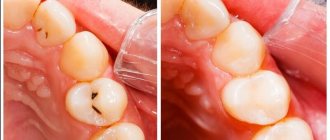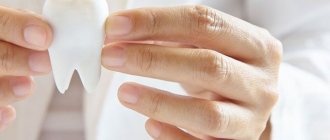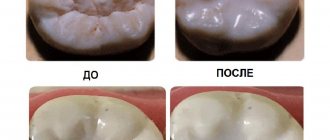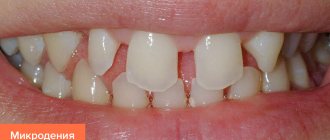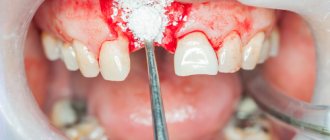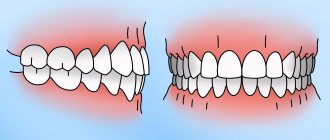Sealing is the filling of the grooves in the teeth with a special composition that allows them to block the proliferation of pathogenic microorganisms.
The grooves in the teeth are called “fissures” and are characteristic mainly of the posterior chewing teeth - molars. They are very thin, and the bristles of the brush are not able to clean everything that is at the bottom of the fissures. As a result of lack of regular brushing, plaque can accumulate in a child's teeth, which will subsequently destroy the enamel, cause tooth decay and possibly reach a nerve (are there also nerves in baby teeth).
What is dental fissure sealing?
Fissure sealing is a safe dental procedure during which a specialist fills the natural crevices of the chewing surface of the teeth with a special liquid polymer (sealant). The fissure of the tooth is sealed with a sealant, which prevents the accumulation of food debris in the cavities of the recesses, which helps prevent the formation of plaque and reduce the risk of developing caries.
According to statistics, timely sealing of fissures can reduce the formation of caries by 90% or more. Therefore, sealing the tooth fissure with a sealant is recognized as an effective method of preventing dental disease and its complications - pulpitis, periodontal inflammation, tooth loss.
Why does fissure caries occur?
Fissure caries occurs for only one reason - poor dental and oral hygiene. If after eating you do not brush your teeth, do not rinse your mouth and perform dental hygiene less than 2 times a day, fissure caries will not keep you waiting, because plaque and food debris quickly accumulate in the pits and depressions on the surfaces of the chewing teeth. This environment is extremely favorable for the development of carious bacteria.
Bacteria will multiply, their vital activity will lead to weakening of the tooth enamel and when it becomes thinner to a certain extent, fissure caries will begin.
Modern sealing methods
The fissure sealing procedure begins with a thorough diagnosis of the general condition of the oral cavity. During its implementation, specialists from the Dental Center on Shabolovka assess the condition of the tooth enamel, the presence or absence of a carious process, the depth and structure of the fissures themselves. After this, one of the methods of sealing the tooth grooves will be selected - non-invasive or invasive.
- A non-invasive sealing technique
is used for open fissures. It does not involve additional opening of natural grooves, and comes down to simply filling visible gaps with dental sealant. - The invasive technique
is used in the presence of deep or closed fissures, the condition of which cannot be monitored visually. To do this, they are first “opened” and then sealed with sealant.
Both sealing methods are safe for the patient's health. At the same time, the non-invasive technique is absolutely painless and does not require the use of anesthesia. While during invasive sealing, the patient may experience discomfort and unpleasant sensations caused by micropreparation of the surface tissues of the tooth. Therefore, the procedure can be performed using local anesthesia, which eliminates any pain.
Fissure caries clinic
The carious process begins secretly and painlessly. Most patients do not attach importance to discoloration in the area of natural recesses of molars and premolars, due to which the pathology intensively develops and spreads to the deeper tissues of the tooth. The main symptoms of fissure caries:
- Changing the natural color of teeth. Due to destruction (destruction) and the activity of microorganisms, dental tissues darken. The fissures become dark brown and clearly visible;
- Hyperesthesia (increased tooth sensitivity). The tooth reacts to temperature and taste stimuli, the patient complains of pain, which goes away when the triggers are eliminated;
- Independent pain syndrome that does not stop after eliminating irritating factors. The pathological process spreads to the dental pulp, which consists of nerve fibers and blood vessels; patients note the nocturnal nature of the attacks. If the pain continues to intensify, caries develops into acute pulpitis.
How sealing occurs: stages
To achieve the maximum preventive effect, the sealing procedure is carried out in several mandatory stages, the sequence of which depends on the chosen technique.
The non-invasive sealing method involves the following steps.
- Thorough cleansing of the treated area from food debris and plaque.
- Drying the tooth surface and fissures.
- Isolation of the treated area from the penetration of saliva with special dental rollers.
- Applying a 32% solution of orthophosphoric acid to the fissure area, which makes the enamel slightly rough, which ensures good adhesion of its surface to the sealant.
- Phosphoric acid is kept on the tooth surface for 30–40 seconds, after which it is thoroughly washed off with distilled water, and the fissures are dried again.
- Carefully apply dental sealant (sealant), which immediately hardens under the influence of a UV lamp.
- Removal of excess sealant by grinding and subsequent polishing of the chewing surface of the tooth. As a result, the sealed fissures look as natural as possible and do not create any discomfort for the patient.
Invasive sealing is very similar to non-invasive sealing, with the only difference being that it involves a few additional steps.
- Cleansing from dental plaque.
- Opening of fissures through micropreparation.
- Drying and isolating the treated area.
- Treatment with 32% phosphoric acid solution.
- Filling open fissures with filling material.
- After the filling material has hardened, the cracks are sealed with sealant.
- Treatment of fissures with a UV lamp.
- Removal of excess material, grinding and polishing.
Regardless of the chosen sealing technique, after the procedure, remineralization and fluoridation of the teeth can be carried out. Thanks to this, it is possible to achieve a high level of dental caries resistance and reliably protect them from disease.
What is fissure caries?
Fissures - this professional term refers to the natural pits and grooves that exist on the surfaces of chewing teeth. In these recesses, food debris clogs and accumulates, and therefore the fissures of the chewing teeth are vulnerable to caries. Therefore, it is so important to thoroughly brush your teeth and clean the fissures of your chewing teeth from plaque and food debris.
Fissure caries is clearly visible on the surface of the tooth, but only if the tooth has open fissures, that is, those natural depressions, the bottom of which is completely visible visually. But chewing teeth also have closed fissures: the structure of this type of fissure is very similar to the structure of a bottle. In closed fissures, only the upper narrow groove is clearly visible upon examination, but in depth it expands and forms a cavity. Diagnosing caries with closed fissures is a difficult task and, of course, you won’t find such caries on your own; you will definitely need to visit a doctor’s office.
In order to prevent fissure caries and begin its treatment in a timely manner, you need to undergo regular preventive examinations at the dentist’s office. Our VENSTOM dental clinic in Moscow uses the most modern diagnostic equipment and techniques to detect and treat caries on time!
Calculate the cost of treatment by taking a short test in 20 seconds!
Do not delay your treatment, because in this matter time plays against us.
What material is the sealant made of?
To seal fissures, special dental sealants are used, which are characterized by good fluidity, allowing them to penetrate even the smallest crevices of the tooth surface. Essentially, these are modern polymers based on methacrylate and polyurethane. Each of them has its own properties, wear resistance, and can harden naturally or under the influence of a UV lamp. Often their composition is additionally enriched with fluoride ions, which strengthens tooth enamel, thereby inhibiting the development of the carious process.
Sealants for sealing fissures differ not only in their composition, but also in their transparency.
- Transparent sealants
allow you to visually monitor the condition of fissures. But due to their colorlessness, they are practically invisible on the surface of the tooth, which makes it difficult to assess the condition of the sealant itself. - Opaque sealants
are sealants that contain titanium dioxide. They are painted in a pleasant milky white color, are hardly noticeable on the chewing surface of the teeth and allow you to monitor the general condition of the sealant during use.
Any sealant composition is well tolerated by the human body, does not cause allergic reactions and does not harm tooth enamel.
Is it possible to cure fissure caries without drilling the tooth?
Fissure caries can be cured without drilling a tooth, but to do this you need to regularly visit the dentist’s office and undergo preventive examinations. If fissure caries is detected at the spot stage, it is treated without drilling the tooth, through remineralization or Icon technology.
From here we can draw a simple conclusion - if you want to treat your teeth without pain and drilling with a drill, you need to pay close attention to the prevention of caries.
Calculate the cost of treatment by taking a short test in 20 seconds!
Do not delay your treatment, because in this matter time plays against us.
Fissure sealing in children: pros and cons
Sealing the tooth fissure with sealant can be done at any age. This procedure is especially indicated for children whose tooth enamel is just beginning to form and the accumulation of plaque in the fissures often provokes the onset of the carious process.
The problem is that a child's baby teeth have a low level of mineralization, which makes them especially vulnerable to tooth decay. Therefore, a preventive examination and the first fissure sealing in children are recommended to be carried out 6 months after the eruption of baby teeth. The effect achieved during the procedure will last for 1 – 2 years, during which it is necessary to undergo a preventive examination by a dentist every 6 months.
Among the advantages of early fissure sealing, the following points can be highlighted.
- The presence of sealant does not disrupt the natural development of the tooth.
- Sealants do not reduce the level of natural mineralization of enamel.
- Sealing the gaps does not have any effect on the formation of a correct bite in the child.
In both children and adults, the presence of sealants in fissures does not cause a feeling of discomfort or stress on the tooth.
Note! To avoid the development of complications, the procedure for sealing cracks should be carried out only by an experienced specialist – a dentist.
Do not ignore preventive visits to the dentist.
It is enough to visit a specialist 1 – 2 times a year, which will allow you to promptly identify any dental problem at an early stage of development. This means that its elimination will be quick, easy and without complications.
By clicking the “request a call” button you agree to the personal data processing policy.
Diagnosis of fissure caries: basic and auxiliary methods
The main diagnosis of fissure caries will consist of visual inspection and probing. If caries has affected the fissures, they will noticeably darken, the tissue in them will soften and the probe that the dentist uses during the examination will get caught on them. But if the caries is still in the staining stage or the tooth has deep and narrow fissures, additional diagnostic measures can be carried out:
- X-ray of a tooth. A fairly effective diagnostic method that allows you to detect fissure caries at the earliest stages of development, since carious lesions will be clearly visible on the pictures;
- Fissurotomy. A specific study that helps to see how deep the carious damage has gone in the tooth. Fissurotomy is carried out as follows: using a drill, the doctor opens the fissures to a small depth (up to 1 mm) and looks at how much caries has managed to destroy the tooth.
Diagnosis of fissure caries can be carried out using a laser. This is the most modern and effective method for diagnosing caries at any stage of its development: the laser is reflected differently from healthy and diseased tooth tissues. The difference in the reflections of the laser beam is noted by the device, which immediately sounds a sound signal. But laser diagnostics of fissure caries is carried out only in those clinics that have the appropriate equipment.
Indications and contraindications
Since fissures are natural crevices on the chewing surface of every person’s teeth, we can say with complete confidence that their sealing is recommended for absolutely everyone. It is especially needed by small children, whose tooth enamel is just forming, and adults, who have deep and narrow fissures that are difficult to clean during daily hygienic brushing.
But we should not forget that natural cracks of a wide structure that communicate with each other can self-clean naturally. Therefore, if there is no threat of caries development, then they do not need to be sealed. In this case, only a dentist can determine the feasibility of the procedure. In addition, sealing may be refused if the following contraindications are present:
- The presence of a carious process that requires treatment.
- If visible fissures do not develop caries within 4 years.
- If a tooth has not fully erupted, its surface cannot be sealed.
- Unsatisfactory general condition of teeth caused by improper or insufficient oral hygiene.
Note! Before carrying out the procedure, it is necessary to undergo an examination by a dentist, who will help identify contraindications to sealing.
When should you resort to sealing?
The process of filling the grooves and grooves formed on the chewing teeth with a specialized product is called fissure sealing. The substance used during the procedure prevents the smallest microorganisms and pieces of food from entering the tooth grooves.
Essentially, the tooth is sealed and is inaccessible to the influence of harmful factors. The means by which sealing is carried out, as a rule, includes fluoride ions, and this makes the enamel resistant to the threat of caries.
The described procedure is performed for both adults and children. Both baby and molar teeth can be “sealed” with a special substance, since caries affects people of any age. However, in children the process of fissure mineralization is lower, so the possibility of enamel defects increases.
There are several indications for this procedure:
- the presence of teeth whose fissures have a complex structure and great depth, which leads to the accumulation of food debris in the grooves;
- the appearance of signs of caries;
- encountered when brushing teeth ;
- identification of pigmented fissures, that is, areas of enamel that are most susceptible to caries;
- the presence of teeth that are not yet four years old.
Indications for sealing are the appearance of weakly mineralized areas on the teeth, as well as the identification of areas susceptible to caries. A professional doctor, after checking the structure of the grooves, will immediately be able to determine the need for this procedure.
Why can our articles be trusted?
We make health information clear, accessible and relevant.
- All articles are checked by practicing doctors.
- We take scientific literature and the latest research as a basis.
- We publish detailed articles that answer all questions.
On the other hand, sealing will be contraindicated if the oral cavity is not well maintained. First, you will need to remove tartar and plaque and teach the patient how to properly care for their teeth. Also, the procedure cannot be carried out if the tooth openings are very wide and connected to each other. In this case, the sealing material may not be applied correctly.
Prevention
According to statistics, 80% of sealants retain their integrity and tightness for 2 to 3 years after the procedure. Over the next 5–7 years, about 70% of sealants successfully withstand. After 10 years, only 30% of sealants remain intact and functional. Thus, modern sealants can serve the patient for a long time. The main thing is to undergo preventive examinations at the dentist in a timely manner and monitor their condition. To do this, you need to visit a specialist at least 1–2 times a year and regularly inspect the sealed fissures yourself. If you notice that part of the sealant has fallen out, you should immediately contact your doctor. Otherwise, it is enough to adhere to the general recommendations of a specialist and pay due attention to daily oral hygiene.
Author: Elena Kopylova Dentist-therapist, endodontist, pediatric dentist. Work experience more than 7 years.
The information is for reference only. Before treatment, consultation with a doctor is necessary.
How will fissure caries be treated?
After diagnosing and diagnosing “fissure caries,” a method of treating it is selected. Since patients usually come to dentists with moderate fissure caries, below we will describe all stages of its treatment.
1. Pain relief. When treating medium fissure caries, the doctor will need to remove all affected and destroyed tissue with a drill. This can be unpleasant for the patient, so local anesthesia is given before treatment begins.
2. After the anesthetic has taken effect, a rubber dam, a special latex overlay, is installed on the area where fissure caries is treated. The rubber dam reliably isolates the area of treatment from saliva and moisture from the oral cavity, which may contain bacteria. In addition, careful isolation of the tooth from moisture is important for high-quality filling. If moisture gets into the cavity at the time of placing the filling, the adhesion between the filling materials and the natural tissues of the tooth will deteriorate and this can lead to the filling falling out.
3. After installing the rubber dam, the dentist will begin working on the tooth. When treating fissure caries, it is extremely important to remove all destroyed and damaged tissue. If this is not done, caries will continue to develop directly under the filling.
4. By removing tissue damaged by fissure caries, the dentist will form a cavity in the tooth for installation of a filling. This cavity is treated with a special etching solution that cleans the tissue, and then an adhesive composition is placed into it.
5. The dentist will restore >the crown of the tooth
The process of treating fissure caries is completed by grinding and polishing the installed filling.
If a tooth is severely damaged by fissure caries, then it is better to restore it not with a filling, but with a special restorative inlay, which can be made of different materials: gold, ordinary metal, ceramics.
Inlays are fixed in the tooth using special cement and differ from fillings in having a longer useful life, and in addition, in reduced risks of developing secondary fissure caries. In addition, fillings even made from the highest quality composites darken over time, but ceramic inlays retain their aesthetic appearance throughout their entire service life. Of course, restoring a tooth with an inlay after treating fissure caries will cost more, but the high cost will be justified by the durability and reliability of the restoration.
Medical Internet conferences
Functions of fissure sealing: creates a barrier for cariogenic bacteria; has a remineralizing effect on enamel if the sealant contains active fluoride ions. Four types of fissure structure : Funnel-shaped fissures are more open, well mineralized, they do not retain food debris due to free washing with oral fluid, and are caries-resistant. Cone-shaped - mainly mineralized due to oral fluid, but conditions appear for the retention of food debris and microorganisms. Mineralization of drop-shaped and polyp-shaped fissures occurs mainly from the pulp of the tooth. This process is less intense than mineralization due to oral fluid, and the fissures remain hypomineralized for a long time. Considering the high caries resistance of hard tissues, fissure sealing is not recommended in teeth with a high initial level of mineralization (ILM). General hygiene measures are sufficient. For teeth with average IUM, immediately after eruption, it is recommended to conduct a month-long course of local application of calcium - phosphate-containing and fluorine-containing preparations, followed by sealing with a composite sealant. For teeth with low fissure IUM, it is not recommended to use composite sealants using 38% phosphoric acid as an etching agent. In this case, glass ionomer sealants are used, or invasive sealing with a composite sealant, or, if indicated, a preventive filling method. The presence of pigmented fissures and natural depressions in teeth at the maturation stage, in contrast to teeth with mature enamel, indicates an actively ongoing process and requires invasive sealing methods. Initial caries is an indication for invasive sealing with composite sealants. Contraindications to sealing: the presence of intact wide, well-connected fissures; teeth with healthy pits and fissures, but with carious lesions on the proximal surfaces; pits and fissures that remain healthy for 4 years or more do not require sealing; poor oral hygiene. Indications for sealing and preventive procedures for fissures of erupting teeth with immature enamel based on fissure enamel electrometry indicators (μA): Low IAM (up to 8 μA) - hygienic measures, observation; average IUM (from 9 to 20 μA) - hygienic measures, a course of fluoride and calcium phosphate-containing drugs, fissure sealing; high IUM (up to 20 μA) - hygienic measures, a course of fluoride and calcium phosphorus-containing drugs, fissure expansion, preventive filling. For fissures after enamel maturation: 0 μA, healthy enamel - hygienic measures, observation 1-2 μA, initial caries - hygienic measures, course of fluoride and calcium phosphate-containing drugs, fissure sealing; up to 8 μA, progressive initial or superficial caries - hygienic measures, a course of fluoride and calcium phosphate-containing drugs, fissure expansion, preventive filling.
This comprehensive approach has been taken into account by the world's leading manufacturers of preventive products. The VOCO company (Germany, Cuxhaven) produces a fluoride-containing rinse aid "Profluoride M", a gel for applications "Profluoride Jelly", a two-component self-curing multi-purpose fluoride-containing varnish "Bifluoride 12", a series of sealants "Fissurit" and a unique highly filled sealant based on ormoker "Admira Seal" "
High efficiency (preventive effect of fissure sealing) is estimated by different authors from 55% (Going, Coti, Hough, 1976) to 99.1% (Buonocore 1974) and the low cost of the fissure sealing method in combination with general comprehensive prevention of dental diseases will significantly reduce the growth rate dental caries in the area of fissures and pits.
Currently, in order to seal blind pits and fissures of teeth, sealants belonging to three classes of materials are used: composite chemo- and photocurable materials, glass ionomer cements and compomers.
The material used to seal fissures (sealant), as a rule, is a special composite resin that is cured chemically or with the help of light. Due to their high fluidity, unfilled sealants easily penetrate even very narrow and deep fissures to their very bottom, leveling the chewing surface of the tooth and facilitating its hygiene. They have better marginal adaptation, longer retention, and wear out faster. Filled sealants have a smaller penetration depth, a smaller micromechanical adhesion area, shorter retention times, but are more resistant to abrasion. They are used for invasive sealing technology, but their application process is relatively complex, time-consuming and moisture-sensitive. Sealants do not adversely affect the normal mineralization process of enamel. Mineral elements from the oral fluid can diffuse freely along the edge and partially through the coating substance itself. This makes it possible to ensure a physiological level of metabolic processes in the hard tissues of the tooth under the coating, while simultaneously preventing the penetration of large protein molecules. The material is moisture-proof and very durable, which allows you to protect your teeth from fissure caries for a long time (up to 5-8 years). In addition, the sealant contributes to the saturation of the tooth enamel and periodontal environment with fluoride in the ion exchange reaction due to the soluble salt (fluorides) added to the composition for 1-28 days.
Types of composite sealants : 1) Self-polymerizing or chemo-curing “Concise White Sealant” (3M, USA), “Delton” (Johnson and Johnson), “Delton”, “Fis Seal” (Russia); 2) Photopolymerizable “Estisial LC” (Kulrer), “Sealant” (Bisco), “Fissurit”, “Fissurit F” (Voco), “Delton-S”, “Fis Sil-S” (Russia), Helioseal, Prisma Sheild .1. Opaque (not transparent) - easy to control, but does not imitate tooth color and it is impossible to monitor the condition of the enamel underneath; 2. Transparent – aesthetically pleasing, allowing observation of the condition of the enamel underneath, but difficult to distinguish when monitoring its safety; a) Colored (chameleons) have a bright color only at the time of polymerization, and after that they correspond to the natural tone of the tooth or are transparent “ClinPro Sealant” (3M ESPE, USA), “Helioseal Cler Chroma” (Ivoclar Vivadent); b) Not painted. A. Containing fluorine (Fissurit); B. Fluoride-free (Fissurit F).
The third generation of CPM - materials that harden under the influence of visible light with a wavelength from 430 to 490 nm (“Fissurit”, “Helioseal”, “Estisial LC”), one-component, long working time, completeness of polymerization is determined by light exposure, risk of destruction during testing curing is minimal. These materials are based on low-viscosity methacrylic acid derivatives. Borosilicate glass with a particle size of 99% less than 1 micron is used as a filler in the preparations, which provides good penetrating properties. At the same time, the release of fluoride from Fissurit F and its entry into the enamel continues for more than 190 days. During this period, Fissurit F releases 4-5 mg of fluoride to strengthen dentin enamel. Another preparation from VOCO (Germany, Cuxhaven) with fluorine, the light-curing sealant “Admira Seal” contains spatially inorganic - organic copolymers (ormokers), providing excellent mechanical properties and ideal biocompatibility (no toxic resin).
The fissure sealing procedure begins with thoroughly cleaning the tooth from plaque with a brush and paste, and then air drying. Next, the fissures are treated with 32% phosphoric acid for etching (a process in which the core or shell of enamel prisms is destroyed by acid) for 30-40 seconds, washed with distilled water and dried again. They are then filled with the liquid phase of the composite filling material. Under the influence of a special lamp, the material hardens in 40-45 seconds, after which the excess is removed with a hard carborundum head and the material is ground on the chewing surface.
The preventive effectiveness of materials is determined by the degree of their preservation in the fissures and the retention of this class of sealants ranges from 20 to 90% and depends on the accuracy of the sealing technology.
Glass ionomer cements - Dyract seal (Dentsply), Prima flou (DG), Vitacryl (Medpolymer), ASPA (Dentsply), Fuji (WHS), Glass Ionomer (Shofu Inc.), Alfa-dent, Aqua Ionoseal (Voco) have a cariesstatic effect , thanks to the F, Al, Zn, Ca contained, due to the release of fluoride, these materials have a pronounced cariesstatic effect. GIC is chemically fixed on the tooth surface, does not require etching of the enamel before the procedure, has high biocompatibility, is less demanding than CPM for drying the working area, but has a number of technological inconveniences (the need for mixing, difficulty in placement, short working time, long curing), low aesthetic properties, low fluidity, large edge leakage, are not strong enough compared to composites, and wear out quickly. For sealing purposes, glass ionomer cements of the second type (intended for filling teeth) can be used for loaded restorations. Some studies suggest that the use of glass ionomer materials as fissure sealants may be appropriate in newly erupted teeth where fissure mineralization is extremely low. The difficulty in such cases is associated with the need for longer etching of the enamel followed by the use of composite sealants. If it is necessary to carry out preventive filling (when, when examining a fissure, the tip of the probe gets stuck in it), we offer condensable, highly aesthetic glass ionomer cement - “VOCO Ionofil Molar” - which has three excellent properties. They are easy to use and less sensitive to execution techniques, which allows them to be used without etching or the use of adhesive. Plastic-free classic glass ionomers have a coefficient of thermal expansion similar to dentin, in addition, they have the so-called “battery” effect of constantly releasing significant amounts of active fluorides. Preservation of GIC after 1, 6, 12, 24 months. is 90, 80, 60 and 20% respectively, after 3 years - 10% (composite sealant - 90%), but, nevertheless, GICs provide a high level of caries reduction of occlusal surfaces - 80-90% in 2 years, teeth , even after macroscopic loss of material, have half the risk of caries than teeth not coated with GIC.
Compomers are light-hardening composite materials that, due to their composition, have some of the properties of glass ionomer cements, namely, slightly greater hydrophilicity, fluidity, and the ability to release fluoride in small amounts than in composites when in contact with oral fluid. The compomer sealant is Dyrect Seal (Dentsply). It is used with NRC (Non-Rise Conditioner) leave-in conditioner and the fifth generation Prime&Bond NT adhesive system, which ensures deeper sealing of fissures with polymer. NRC conditioner simultaneously partially dissolves mineral components and primes tooth tissue; Prime&Bond NT is applied on top of it, to which the sealant itself is fixed. The developers of this system consider this technique as an alternative to invasive fissure sealing. The wear of compomer sealants is higher and retention is lower than that of CPM. Over 2 years, the safety of the sealant-composite is 32%, the sealant-compomer is 0%; complete loss - 10 and 38%, respectively, but after the loss of the compomer, caries develops less frequently than after the loss of the compomer. The effectiveness of caries prevention has been confirmed by many studies. Coating teeth with fluoride-containing varnish led to a reduction in the increase in caries on treated surfaces by up to 70% and a decrease in the risk factor by up to 35%. The highest effectiveness of caries prevention is ensured by the fissure sealing method: the reduction in the increase in fissure caries over the year was 92.5%. Achieving high results of prevention through sealing is due to the performance of two main functions of sealants: 1. Creation of a physical barrier to cariogenic factors on the tooth surface. 2. Remineralization of enamel in the fissure area, if the sealant contains active fluoride ions.
Research results
An assessment of the effectiveness of sealants showed that the reduction in the increase in dental caries depends on the retention of sealants on the occlusal surfaces of the teeth, the ability to release fluoride ions into the tooth tissue and oral fluid, and the effectiveness of caries prevention in permanent teeth increases significantly when sealing fissures and pits is combined with local fluoride prevention and hygiene oral cavity.
Scientific studies have proven that a correctly performed procedure is 100% effective in protecting tooth surfaces from caries, since it serves as a physical barrier to possible destruction. The effectiveness of the procedure is suspended or stopped when the adhesive substances between the film and the tooth are destroyed or part of them is lost. However, teeth that are sealed are significantly less likely to develop caries in the future than those that were never treated. The seal is effective for 5 years but can retain its properties for up to 10 years. Doctors' reports show that 7 years after sealing, about 49% of teeth remain completely sealed. But sealing should not be considered a permanent procedure. Regular visits to the dentist are necessary for preventive examinations, which will allow you to monitor the condition of sealed teeth.
